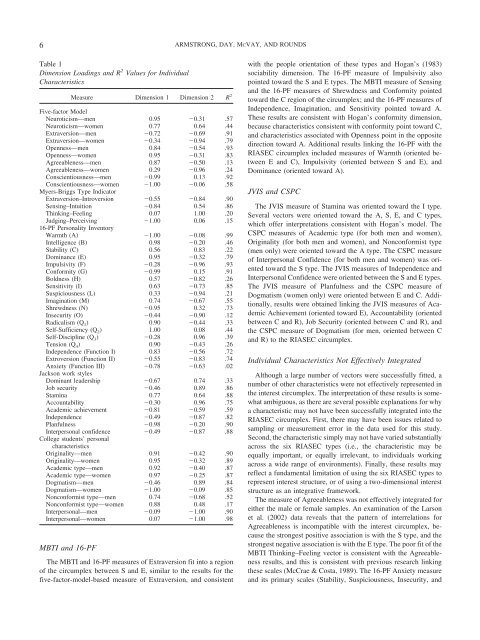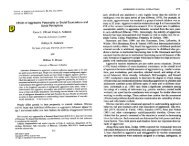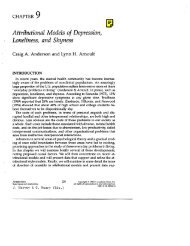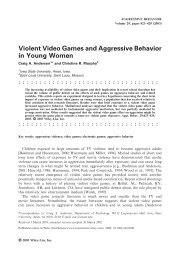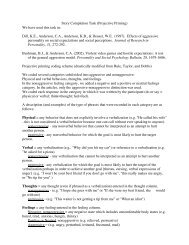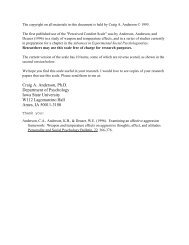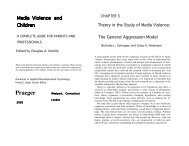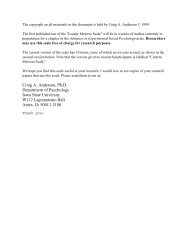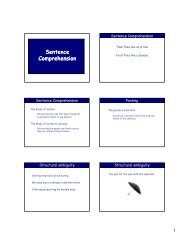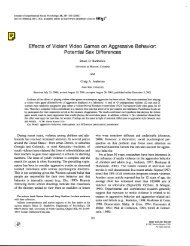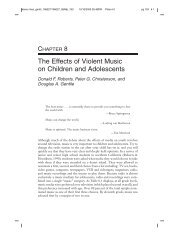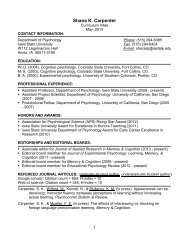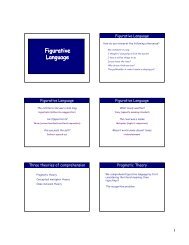Holland's RIASEC Model as an Integrative Framework for Individual ...
Holland's RIASEC Model as an Integrative Framework for Individual ...
Holland's RIASEC Model as an Integrative Framework for Individual ...
You also want an ePaper? Increase the reach of your titles
YUMPU automatically turns print PDFs into web optimized ePapers that Google loves.
6 ARMSTRONG, DAY, MCVAY, AND ROUNDS<br />
Table 1<br />
Dimension Loadings <strong>an</strong>d R 2 Values <strong>for</strong> <strong>Individual</strong><br />
Characteristics<br />
MBTI <strong>an</strong>d 16-PF<br />
Me<strong>as</strong>ure Dimension 1 Dimension 2 R 2<br />
Five-factor <strong>Model</strong><br />
Neuroticism—men 0.95 0.31 .57<br />
Neuroticism—women 0.77 0.64 .44<br />
Extraversion—men 0.72 0.69 .91<br />
Extraversion—women 0.34 0.94 .79<br />
Openness—men 0.84 0.54 .93<br />
Openness—women 0.95 0.31 .83<br />
Agreeableness—men 0.87 0.50 .13<br />
Agreeableness—women 0.29 0.96 .24<br />
Conscientiousness—men 0.99 0.13 .92<br />
Conscientiousness—women 1.00 0.06 .58<br />
Myers-Briggs Type Indicator<br />
Extraversion–Introversion 0.55 0.84 .90<br />
Sensing–Intuition 0.84 0.54 .86<br />
Thinking–Feeling 0.07 1.00 .20<br />
Judging–Perceiving 1.00 0.06 .15<br />
16-PF Personality Inventory<br />
Warmth (A) 1.00 0.08 .99<br />
Intelligence (B) 0.98 0.20 .46<br />
Stability (C) 0.56 0.83 .22<br />
Domin<strong>an</strong>ce (E) 0.95 0.32 .79<br />
Impulsivity (F) 0.28 0.96 .93<br />
Con<strong>for</strong>mity (G) 0.99 0.15 .91<br />
Boldness (H) 0.57 0.82 .26<br />
Sensitivity (I) 0.63 0.73 .85<br />
Suspiciousness (L) 0.33 0.94 .21<br />
Imagination (M) 0.74 0.67 .55<br />
Shrewdness (N) 0.95 0.32 .73<br />
Insecurity (O) 0.44 0.90 .12<br />
Radicalism (Q 1 ) 0.90 0.44 .33<br />
Self-Sufficiency (Q 2 ) 1.00 0.08 .44<br />
Self-Discipline (Q 3 ) 0.28 0.96 .39<br />
Tension (Q 4 ) 0.90 0.43 .26<br />
Independence (Function I) 0.83 0.56 .72<br />
Extroversion (Function II) 0.55 0.83 .74<br />
Anxiety (Function III) 0.78 0.63 .02<br />
Jackson work styles<br />
Domin<strong>an</strong>t leadership 0.67 0.74 .33<br />
Job security 0.46 0.89 .86<br />
Stamina 0.77 0.64 .88<br />
Accountability 0.30 0.96 .75<br />
Academic achievement 0.81 0.59 .59<br />
Independence 0.49 0.87 .82<br />
Pl<strong>an</strong>fulness 0.98 0.20 .90<br />
Interpersonal confidence 0.49 0.87 .88<br />
College students’ personal<br />
characteristics<br />
Originality—men 0.91 0.42 .90<br />
Originality—women 0.95 0.32 .89<br />
Academic type—men 0.92 0.40 .87<br />
Academic type—women 0.97 0.25 .87<br />
Dogmatism—men 0.46 0.89 .84<br />
Dogmatism—women 1.00 0.09 .85<br />
Noncon<strong>for</strong>mist type—men 0.74 0.68 .52<br />
Noncon<strong>for</strong>mist type—women 0.88 0.48 .17<br />
Interpersonal—men 0.09 1.00 .90<br />
Interpersonal—women 0.07 1.00 .98<br />
The MBTI <strong>an</strong>d 16-PF me<strong>as</strong>ures of Extraversion fit into a region<br />
of the circumplex between S <strong>an</strong>d E, similar to the results <strong>for</strong> the<br />
five-factor-model-b<strong>as</strong>ed me<strong>as</strong>ure of Extraversion, <strong>an</strong>d consistent<br />
with the people orientation of these types <strong>an</strong>d Hog<strong>an</strong>’s (1983)<br />
sociability dimension. The 16-PF me<strong>as</strong>ure of Impulsivity also<br />
pointed toward the S <strong>an</strong>d E types. The MBTI me<strong>as</strong>ure of Sensing<br />
<strong>an</strong>d the 16-PF me<strong>as</strong>ures of Shrewdness <strong>an</strong>d Con<strong>for</strong>mity pointed<br />
toward the C region of the circumplex; <strong>an</strong>d the 16-PF me<strong>as</strong>ures of<br />
Independence, Imagination, <strong>an</strong>d Sensitivity pointed toward A.<br />
These results are consistent with Hog<strong>an</strong>’s con<strong>for</strong>mity dimension,<br />
because characteristics consistent with con<strong>for</strong>mity point toward C,<br />
<strong>an</strong>d characteristics <strong>as</strong>sociated with Openness point in the opposite<br />
direction toward A. Additional results linking the 16-PF with the<br />
<strong>RIASEC</strong> circumplex included me<strong>as</strong>ures of Warmth (oriented between<br />
E <strong>an</strong>d C), Impulsivity (oriented between S <strong>an</strong>d E), <strong>an</strong>d<br />
Domin<strong>an</strong>ce (oriented toward A).<br />
JVIS <strong>an</strong>d CSPC<br />
The JVIS me<strong>as</strong>ure of Stamina w<strong>as</strong> oriented toward the I type.<br />
Several vectors were oriented toward the A, S, E, <strong>an</strong>d C types,<br />
which offer interpretations consistent with Hog<strong>an</strong>’s model. The<br />
CSPC me<strong>as</strong>ures of Academic type (<strong>for</strong> both men <strong>an</strong>d women),<br />
Originality (<strong>for</strong> both men <strong>an</strong>d women), <strong>an</strong>d Noncon<strong>for</strong>mist type<br />
(men only) were oriented toward the A type. The CSPC me<strong>as</strong>ure<br />
of Interpersonal Confidence (<strong>for</strong> both men <strong>an</strong>d women) w<strong>as</strong> oriented<br />
toward the S type. The JVIS me<strong>as</strong>ures of Independence <strong>an</strong>d<br />
Interpersonal Confidence were oriented between the S <strong>an</strong>d E types.<br />
The JVIS me<strong>as</strong>ure of Pl<strong>an</strong>fulness <strong>an</strong>d the CSPC me<strong>as</strong>ure of<br />
Dogmatism (women only) were oriented between E <strong>an</strong>d C. Additionally,<br />
results were obtained linking the JVIS me<strong>as</strong>ures of Academic<br />
Achievement (oriented toward E), Accountability (oriented<br />
between C <strong>an</strong>d R), Job Security (oriented between C <strong>an</strong>d R), <strong>an</strong>d<br />
the CSPC me<strong>as</strong>ure of Dogmatism (<strong>for</strong> men, oriented between C<br />
<strong>an</strong>d R) to the <strong>RIASEC</strong> circumplex.<br />
<strong>Individual</strong> Characteristics Not Effectively Integrated<br />
Although a large number of vectors were successfully fitted, a<br />
number of other characteristics were not effectively represented in<br />
the interest circumplex. The interpretation of these results is somewhat<br />
ambiguous, <strong>as</strong> there are several possible expl<strong>an</strong>ations <strong>for</strong> why<br />
a characteristic may not have been successfully integrated into the<br />
<strong>RIASEC</strong> circumplex. First, there may have been issues related to<br />
sampling or me<strong>as</strong>urement error in the data used <strong>for</strong> this study.<br />
Second, the characteristic simply may not have varied subst<strong>an</strong>tially<br />
across the six <strong>RIASEC</strong> types (i.e., the characteristic may be<br />
equally import<strong>an</strong>t, or equally irrelev<strong>an</strong>t, to individuals working<br />
across a wide r<strong>an</strong>ge of environments). Finally, these results may<br />
reflect a fundamental limitation of using the six <strong>RIASEC</strong> types to<br />
represent interest structure, or of using a two-dimensional interest<br />
structure <strong>as</strong> <strong>an</strong> integrative framework.<br />
The me<strong>as</strong>ure of Agreeableness w<strong>as</strong> not effectively integrated <strong>for</strong><br />
either the male or female samples. An examination of the Larson<br />
et al. (2002) data reveals that the pattern of interrelations <strong>for</strong><br />
Agreeableness is incompatible with the interest circumplex, because<br />
the strongest positive <strong>as</strong>sociation is with the S type, <strong>an</strong>d the<br />
strongest negative <strong>as</strong>sociation is with the E type. The poor fit of the<br />
MBTI Thinking–Feeling vector is consistent with the Agreeableness<br />
results, <strong>an</strong>d this is consistent with previous research linking<br />
these scales (McCrae & Costa, 1989). The 16-PF Anxiety me<strong>as</strong>ure<br />
<strong>an</strong>d its primary scales (Stability, Suspiciousness, Insecurity, <strong>an</strong>d


